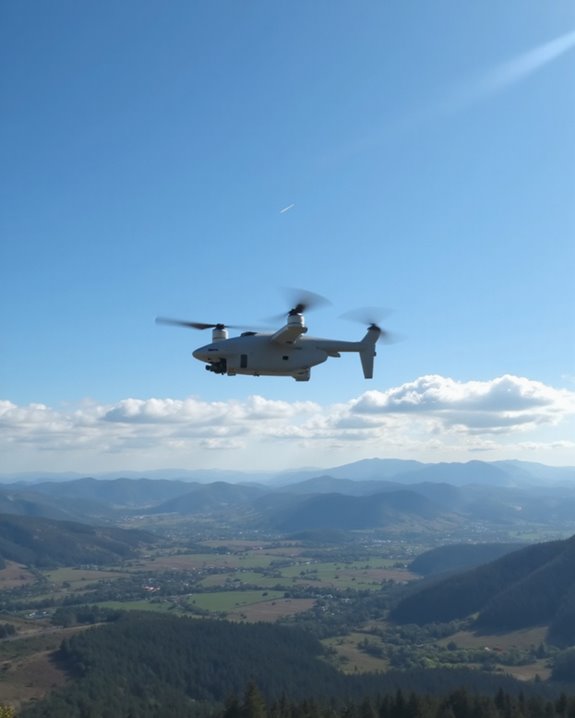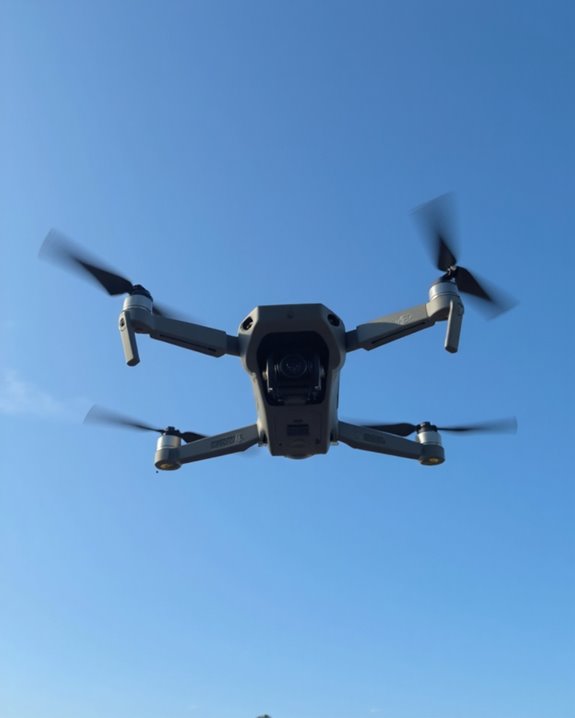Mastering quadrocopter controls in War Thunder requires strategic key mapping and view management. Players should launch drones from covered positions, toggle between camera views with the “V” key, and utilize thermal vision to spot camouflaged enemies. Effective reconnaissance demands maintaining stability while scouting positions up to a kilometer away. Remember to space launches 10 seconds apart and use terrain for cover! These unmanned scouts serve as force multipliers rather than direct combat assets. The difference between victory and ambush often hinges on your drone piloting finesse.
Key Takeaways
- Map key bindings for essential actions like view switching, camera adjustments, and weapon mode toggling.
- Toggle between manual and automatic stabilization for battlefield adaptation and steady surveillance.
- Master thermal vision modes to spot camouflaged enemies in various environments.
- Launch drones from covered positions and scout areas up to one kilometer away.
- Execute strategic flight paths using terrain features for cover and optimal reconnaissance.
Drone Deployment: Getting Started With Quadrocopters
The world of quadrocopter drone operation begins with mastering proper deployment techniques. Players must first understand how to launch these versatile reconnaissance tools from properly equipped ground vehicles during active combat scenarios. Quadcopter Selection is essential, as different models offer varying capabilities for battlefield surveillance!
Training Simulations provide the perfect opportunity to practice deployment timing and positioning without risking valuable assets. Remember, launching your drone from covered positions greatly reduces detection risk, giving you the tactical edge. Most quadrocopters can scout areas up to a kilometer away, revealing enemy positions that would otherwise remain hidden from view.
After activation, operators can seamlessly switch between vehicle and drone controls, creating a dynamic battlefield presence. For maximum effectiveness, coordinate with teammates to share intelligence gathered during your aerial reconnaissance missions.
Many models feature a control range of over 3000 meters, allowing extensive battlefield surveillance without losing connection.
Essential Control Setup and Key Bindings
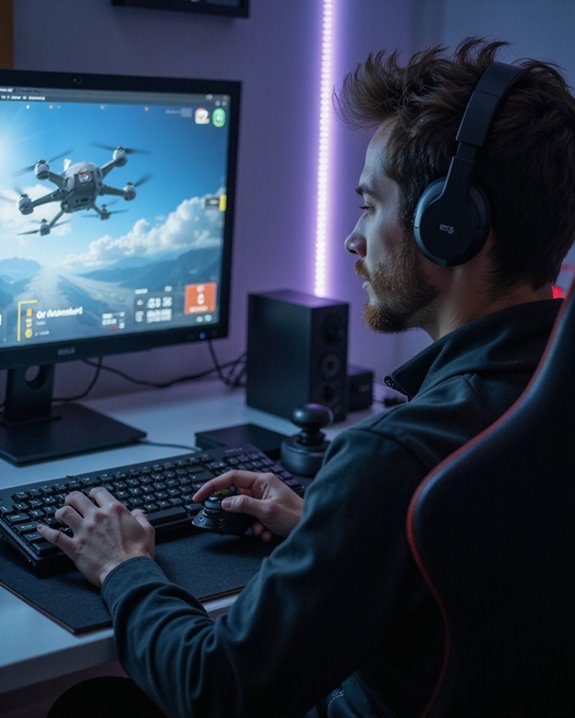
Mastering ideal control setup and key bindings represents the foundation of effective quadrocopter operation in combat scenarios! Players must prioritize throttle management settings to prevent structural damage during rapid altitude changes. Key remapping of frequently used actions—like weapon mode toggling and stabilization controls—to accessible positions dramatically improves reaction times during engagement.
Smart button mapping places missile launch sequences and camera angle adjustments within easy reach, while profile switching between pre-configured setups for air-to-air and air-to-ground missions eliminates mid-battle fumbling. Who wants to search for the thermal vision button while dodging enemy fire, right? The most successful drone pilots create intuitive configurations that match their personal playstyle, placing stabilization modes and view switching commands where muscle memory can take over during intense combat situations! Utilizing controllers with ultra-responsive performance such as the STARDRONE S8 can further enhance control precision and reaction speed in simulations and real flights.
Mastering Camera and View Modes
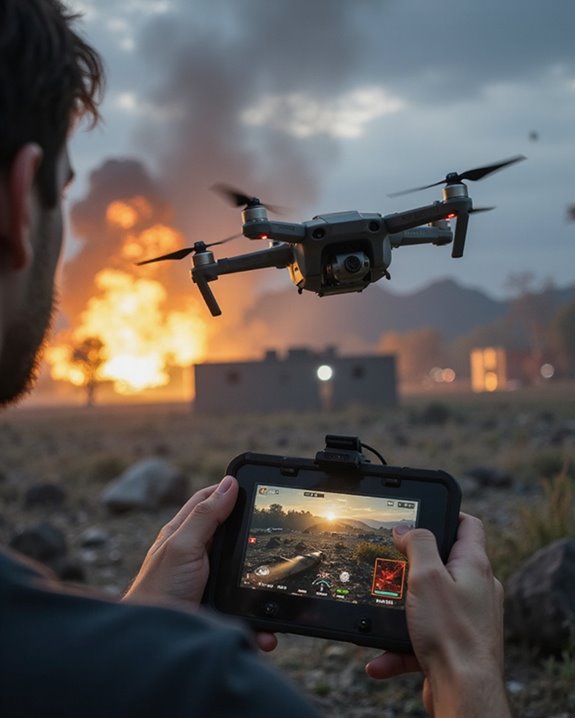
How effectively players manipulate camera systems on quadrocopter drones can make the difference between victory and defeat in War Thunder! The drone’s three primary Rotating Views—third-person, free-tip camera, and thermal—each serve unique tactical purposes. Switching between them with the default “V” key (or your own Mode Customization preference) keeps you adaptable in any situation!
The TV camera’s zoom functionality lets you spot enemies with pinpoint accuracy, while the orbit mode frees you from flying duties. Just set your drone to circle an area and focus on surveillance—talk about multitasking! The stabilization features keep your view steady, perfect for those precision missile locks when every second counts. Remember, customizing your camera controls in the settings menu will transform you from drone novice to reconnaissance maestro in no time! For the best thermal detection, make sure your drone camera includes a 3-axis gimbal system to maintain image stability during aggressive maneuvers.
Stabilization Techniques for Precision Targeting
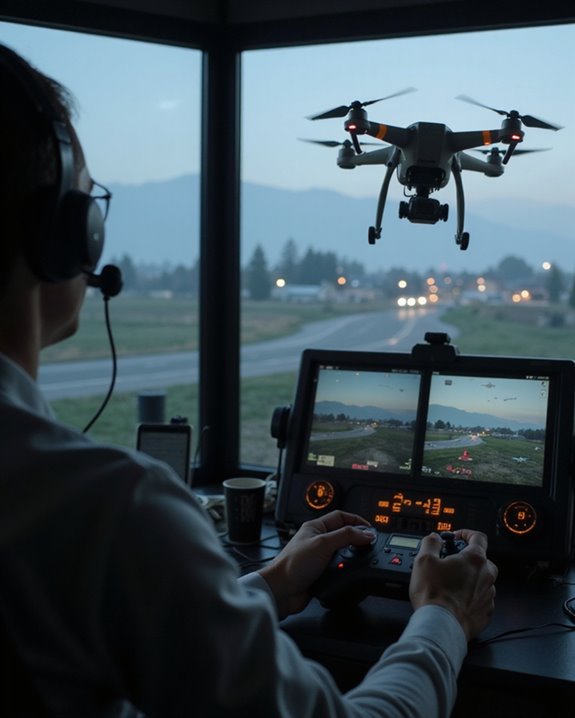
When aerial precision meets battlefield awareness, true quadrocopter mastery begins! Effective drone operators understand that stability is the foundation of successful reconnaissance. By toggling between manual and automatic stabilization modes, pilots can adapt to changing battlefield conditions and maintain target lock despite turbulence handling challenges.
The drone’s inertial damping system works wonders when orbiting locations of interest, allowing for consistent surveillance without constant manual adjustments. Weather conditions and environmental obstacles may throw your drone off balance, but with practice, you’ll maintain rock-solid stability! For precision targeting, remember to utilize the camera lock function to maintain focus on a single location while your team advances.
Missile Launch Mechanics and Timing
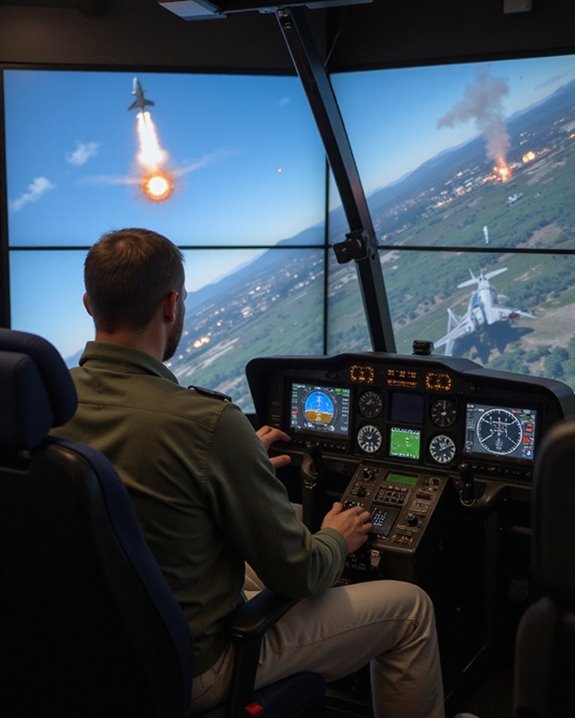
The art of missile deployment transforms your quadrocopter from a surveillance tool into a formidable weapons platform! Successful launches require attention to several critical pre-launch conditions: dive to reduce wing stress, throttle to zero, switch to thermal vision, and align properly with your target.
Timing is everything when launching missiles! The targeting reticle must be solid (not blinking) to indicate readiness, and you’ll want to space multiple launches about 10 seconds apart. This compensates for the slower Missile Velocity and prevents guidance overlap.
Remember that Guidance Algorithms work best when you maintain line of sight with your target. Toggle stabilization mode to lock onto enemies, giving you that satisfying targeting square that improves hit probability. Thermal vision isn’t just for show—it greatly enhances target visibility during those vital post-launch moments!
Advanced Reconnaissance Strategies
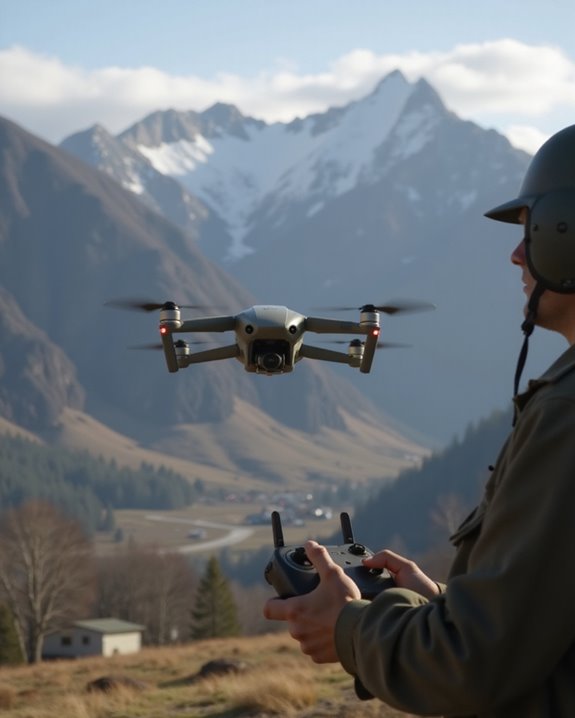
Mastering reconnaissance transforms your quadrocopter from a simple flying device into a powerful intelligence-gathering asset! Pilots who utilize drones effectively gain a tremendous battlefield advantage by spotting enemies without exposing themselves to danger. The real-time intel allows for swift tactical decisions that can turn the tide of battle.
Stealth Operations represent a critical skill set, enabling your drone to remain undetected while gathering valuable information. Position your quadrocopter behind terrain features or utilize low-light conditions to reduce visibility to hostile forces. When spotted, execute Evasive Maneuvers immediately – quick altitude changes and unpredictable movement patterns will help you avoid enemy fire! Remember to share gathered intel with teammates for maximum effectiveness. A well-piloted reconnaissance drone isn’t just surviving the battlefield – it’s actively shaping the outcome of engagements!
Team Coordination and Enemy Marking
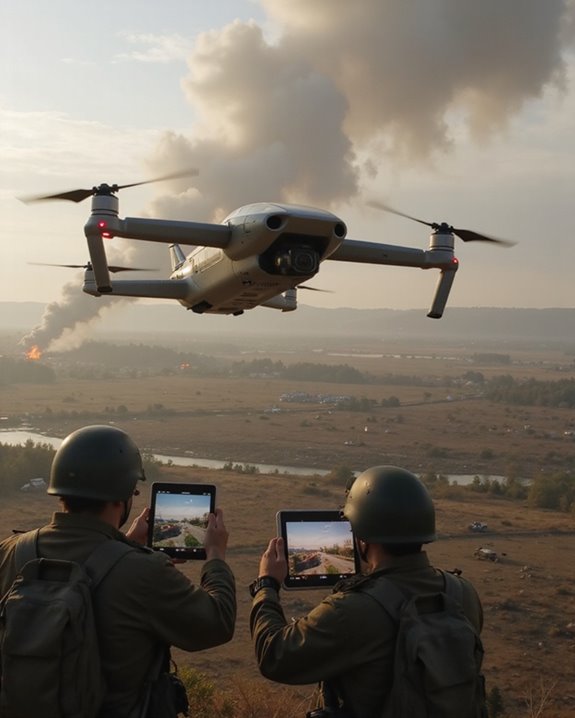
Effective pilots understand that a quadrocopter’s true power emerges through seamless team coordination and precise enemy marking! When utilized properly, drones become the eyes in the sky that dramatically enhance Team Synergy across the battlefield. By identifying and tagging enemy positions, pilots provide invaluable intelligence that allows squadmates to execute coordinated strikes with devastating efficiency.
The real-time Enemy Alerts generated by well-piloted drones reduce friendly casualties and create opportunities for tactical superiority. Think of yourself as the battlefield’s information broker—your reconnaissance efforts can make the difference between a chaotic skirmish and a precision operation! Smart pilots prioritize wide-field scanning and consistent communication, ensuring teammates receive actionable intelligence. Remember, a single well-placed marker can transform five individual players into a cohesive fighting force capable of dominating even the most challenging engagements.
Thermal Vision and Target Acquisition
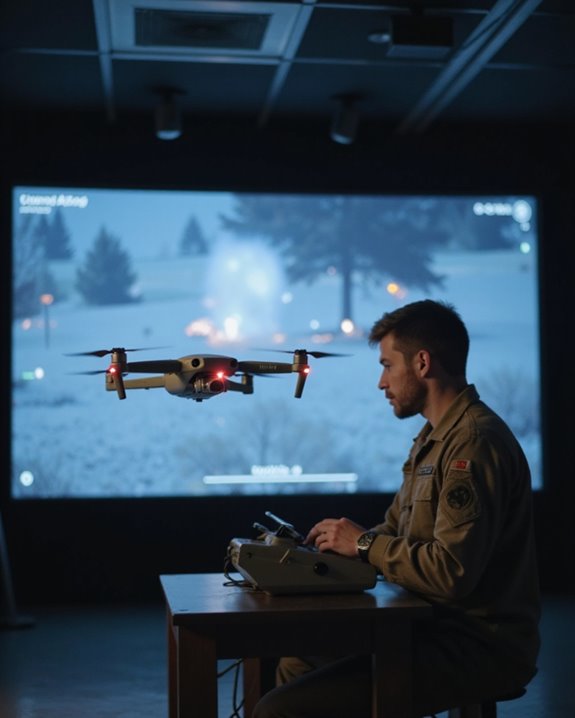
Superior battlefield awareness begins with thermal vision capabilities that transform average pilots into reconnaissance experts! While basic quadrocopters lack built-in thermal imaging, higher-tier drones launched from rank VII light tanks offer this game-changing feature. The Thermal History of warfare has shown that detection technology often determines battlefield outcomes, and War Thunder’s Vision Innovations reflect this reality.
Toggle between White Hot and Black Hot modes to spot camouflaged enemies hiding in dense foliage or urban environments! Weather conditions like fog can limit effectiveness, but combining thermal vision with other sensors creates a powerful reconnaissance toolkit. When operating at night, thermal vision gives you that vital edge over opponents still squinting into the darkness. Remember, thermal capabilities aren’t just fancy tech—they’re your early warning system that turns potential ambushes into your tactical advantage!
Overcoming Quadrocopter Limitations in Combat
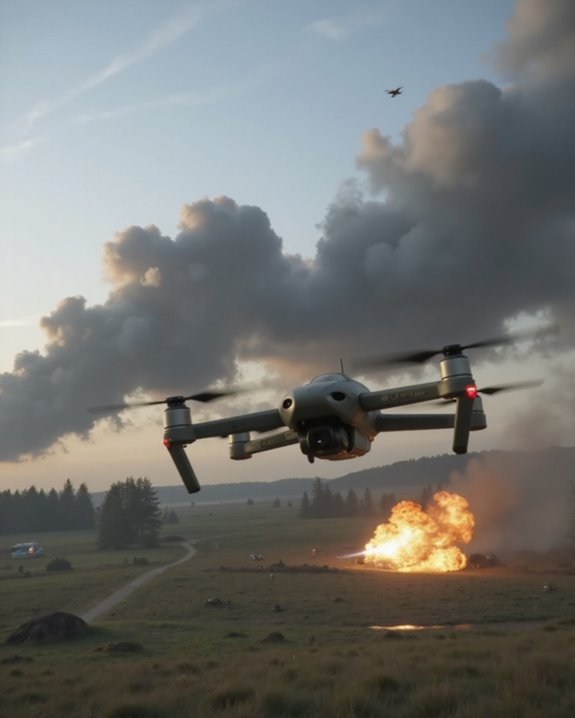
Why do quadrocopter drones often fail to reach their full potential in War Thunder? Many players deploy these nimble surveillance tools without understanding their inherent limitations or how to work around them! The key lies in mastering Endurance Tactics that maximize their limited flight time and range—like using terrain for cover and planning efficient flight paths.
Smart Payload Strategies can compensate for their minimal combat capability. Though quadcopters carry smaller payloads than fixed-wing drones, players can leverage their exceptional maneuverability to scout enemy positions and coordinate team attacks. Think of your quadcopter as a force multiplier, not a direct combat asset!
Weather conditions and visibility factors also impact performance, so timing your deployment during ideal conditions can mean the difference between gathering vital intel or losing your drone to enemy fire.
Frequently Asked Questions
Can Drones Be Shot Down by Enemy Aircraft or Anti-Air?
Yes, drones exhibit significant vulnerability to both enemy aircraft and anti-aircraft defenses in War Thunder. Despite employing evasion tactics like high-speed maneuvers, they remain susceptible targets that can be effectively neutralized by opposing forces.
What Is the Maximum Altitude and Operational Range of Quadrocopter Drones?
Quadrocopter drones typically operate at a regulatory maximum of 400 feet Altitude, though some reach 20,000+ feet with authorization. Operational Range spans 1-5 miles, extending to 100 kilometers, influenced by Weather conditions and Terrain obstacles.
Do Different Vehicles Deploy Drones With Varying Capabilities or Armaments?
Yes, different vehicles deploy drones with varying capabilities and armaments. Drone upgrades depend on the host vehicle’s role, with scout drones focusing on reconnaissance while strike drones offer offensive capabilities through vehicle customization options.
How Long Can Drones Remain Airborne Before Needing to Return?
Drone battery life in War Thunder is unlimited, defying usual endurance factors. The game doesn’t implement time restrictions for airborne scout drones, allowing players to maintain surveillance as long as the drone remains intact.
Can Enemies Detect When They’re Being Observed by Your Drone?
Enemies can visually detect drones in Arcade mode but lack explicit notifications of being observed. No DroneCamouflage or SignalJamming features exist, though players may infer observation when spotting drones flying overhead.




